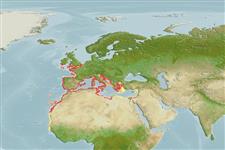Teleostei (teleosts) >
Blenniiformes (Blennies) >
Tripterygiidae (Triplefin blennies) > Tripterygiinae
Etymology: Tripterygion: Greek, tres tria = three + Greek, pteron = wing, fin; diminutive (Ref. 45335).
Environment: milieu / climate zone / depth range / distribution range
Ecology
Marine; demersal; depth range 0 - 40 m (Ref. 4785), usually 6 - 12 m (Ref. 4785). Subtropical; 52°N - 12°N, 19°W - 36°E
Eastern Atlantic and Mediterranean Sea: English Channel southwards and along the coast of west Africa, including Madeira and the Canary Islands (Ref. 4785), south to Senegal.
Size / Weight / Age
Maturity: Lm ? range ? - ? cm
Max length : 8.9 cm TL male/unsexed; (Ref. 5294); common length : 6.0 cm TL male/unsexed; (Ref. 5294)
Adults inhabit shallow coastal waters with rocky substrate. They are found under overhanging rocks, entrances of caves and other biotopes with reduced light. In the Atlantic, they occur in shallow, light-exposed biotopes. They feed on benthic invertebrates, also on harpacticoids (Ref. 4785), amphipods and other copepods (Ref. 94105). Males court by figure-8-swimming (Ref. 4785). Eggs are hemispherical and covered with numerous sticky threads that anchor them in the algae on the nesting sites (Ref. 240). Larvae are planktonic which occur primarily in shallow, nearshore waters (Ref. 94114).
Life cycle and mating behavior
Maturity | Reproduction | Spawning | Eggs | Fecundity | Larvae
Wirtz, P., 1990. Tripterygiidae. p. 916-917. In J.C. Quero, J.C. Hureau, C. Karrer, A. Post and L. Saldanha (eds.) Check-list of the fishes of the eastern tropical Atlantic (CLOFETA). JNICT, Lisbon; SEI, Paris; and UNESCO, Paris. Vol. 2. (Ref. 5294)
IUCN Red List Status (Ref. 130435)
Threat to humans
Harmless
Human uses
Aquarium: potential
More information
Age/SizeGrowthLength-weightLength-lengthLength-frequenciesMorphometricsMorphologyLarvaeLarval dynamicsRecruitmentAbundanceBRUVS
ReferencesAquacultureAquaculture profileStrainsGeneticsElectrophoresesHeritabilityDiseasesProcessingNutrientsMass conversion
Tools
Special reports
Download XML
Internet sources
Estimates based on models
Preferred temperature (Ref.
123201): 12.5 - 21, mean 18.7 °C (based on 609 cells).
Phylogenetic diversity index (Ref.
82804): PD
50 = 0.5625 [Uniqueness, from 0.5 = low to 2.0 = high].
Bayesian length-weight: a=0.00562 (0.00258 - 0.01228), b=3.08 (2.89 - 3.27), in cm total length, based on LWR estimates for this (Sub)family-body shape (Ref.
93245).
Trophic level (Ref.
69278): 3.4 ±0.44 se; based on food items.
Resilience (Ref.
120179): High, minimum population doubling time less than 15 months (Preliminary K or Fecundity.).
Fishing Vulnerability (Ref.
59153): Low vulnerability (10 of 100).
Nutrients (Ref.
124155): Calcium = 360 [191, 886] mg/100g; Iron = 2.16 [1.12, 4.22] mg/100g; Protein = 18.4 [17.3, 19.5] %; Omega3 = 0.264 [0.123, 0.562] g/100g; Selenium = 30.7 [11.3, 72.4] μg/100g; VitaminA = 11.1 [2.9, 41.2] μg/100g; Zinc = 1.65 [1.01, 2.57] mg/100g (wet weight);
